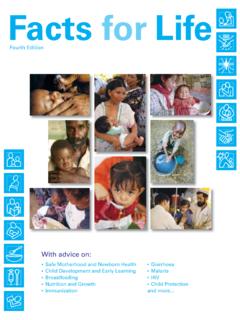Transcription of NES FOR SAFE RECREA Guidelines for Safe Recreational …
1 Guidelines FOR safe Recreational water ENVIRONMENTS VOLUME 2. SWIMMING POOLS AND SIMILAR ENVIRONMENTS. Guidelines for safe Recreational water Environments Volume 2: Swimming Pools and Similar Environments provides an authoritative referenced review and Guidelines for assessment of the health hazards associated with Recreational waters of this type;. their monitoring and assessment; and activities available for their control through education of users, good design and construction, and good operation and safe Recreational water management. The Guidelines include both specific guideline values and good practices.
2 They address a wide range of types of hazard, including hazards leading environments to drowning and injury, water quality, contamination of associated facilities and VOLUME 2. air quality. SWIMMING POOLS AND. The preparation of this volume has covered a period of over a decade and has involved the participation of numerous institutions and more than 60 experts from SIMILAR ENVIRONMENTS. 20 countries worldwide. This is the first international point of reference to provide comprehensive guidance for managing swimming pools and similar facilities so that health benefits are maximized while negative public health impacts are minimized.
3 This volume will be useful to a variety of different stakeholders with interests in ensuring the safety of pools and similar environments, including national and local authorities; facility owners, operators and designers (public, semi-public and domestic facilities); special interest groups; public health professionals; scientists and researchers; and facility users. ISBN 92 4 154680 8. WHO. Guidelines for safe Recreational water environments VOLUME 2: SWIMMING POOLS AND SIMILAR. ENVIRONMENTS. WORLD HEALTH ORGANIZATION. 2006. layout safe 1 9:56:44. WHO Library Cataloguing-in-Publication Data World Health Organization.
4 Guidelines for safe Recreational water environments. Volume 2, Swimming pools and similar environments. pools standards quality analysis prevention and control and injuries prevention and control management values : Swimming pools and similar environments. ISBN 92 4 154680 8 (NLM classification: WA 820). World Health Organization 2006. All rights reserved. Publications of the World Health Organization can be obtained from WHO Press, World Health Organization, 20 Avenue Appia, 1211 Geneva 27, Switzerland (tel.: +41 22 791 2476; fax: + 41 22 791 4857; email: Requests for permission to reproduce or translate WHO publications whether for sale or for noncommercial distribution should be addressed to WHO Press, at the above address (fax: +41 22 791 4806.))
5 Email: The designations employed and the presentation of the material in this publication do not imply the expression of any opinion whatsoever on the part of the World Health Organization concerning the legal status of any country, territory, city or area or of its authorities, or concerning the delimitation of its frontiers or boundaries. Dotted lines on maps represent approximate border lines for which there may not yet be full agreement. The mention of specific companies or of certain manufacturers' products does not imply that they are endorsed or recommended by the World Health Organization in preference to others of a similar nature that are not mentioned.
6 Errors and omissions excepted, the names of proprietary products are distinguished by initial capital letters. All reasonable precautions have been taken by the World Health Organization to verify the information contained in this publication. However, the published material is being distributed without warranty of any kind, either express or implied. The responsibility for the interpretation and use of the material lies with the reader. In no event shall the World Health Organization be liable for damages arising from its use. Design by minimum graphics Typeset by Strategic communications SA, Geneva Printed in France layout safe 2 9:56:45.
7 Contents List of acronyms and abbreviations vi Preface viii Acknowledgements x Executive summary xiii chapter 1. INTRODUCTION 1. General considerations 1. Types of pools 3. Types of users 4. Hazard and risk 5. Types of hazard encountered 5. Assessment of hazard and risk 6. Degree of water contact 8. Measures to reduce risks 9. Nature of the Guidelines 9. References 10. chapter 2. DROWNING AND INJURY PREVENTION 12. Drowning 12. Contributory factors 14. Preventive and management actions 15. Spinal injury 16. Contributory factors 18. Preventive and management actions 18.
8 Brain and head injuries 19. Fractures, dislocations, other impact injuries, cuts and lesions 19. Disembowelment 20. Hazards associated with temperature extremes 20. Injuries associated with feature pools' 21. References 22. chapter 3. MICROBIAL HAZARDS 26. Faecally-derived viruses 28. Hazard identification 28. Outbreaks of viral illness associated with pools 28. iii layout safe 3 9:56:45. Risk assessment 31. Risk management 32. Faecally-derived bacteria 33. Hazard identification 33. Outbreaks of bacterial illness associated with pools 33. Risk assessment 34. Risk management 35.
9 Faecally-derived protozoa 35. Hazard identification 35. Outbreaks of protozoan illness associated with pools 35. Risk assessment 38. Risk management 39. Non-faecally-derived bacteria 40. Legionella spp. 40. Pseudomonas aeruginosa 43. Mycobacterium spp. 45. Staphylococcus aureus 46. Leptospira interrogans sensu lato 47. Non-faecally-derived viruses 48. Molluscipoxvirus 48. Papillomavirus 49. Non-faecally-derived protozoa 49. Naegleria fowleri 50. Acanthamoeba spp. 51. Plasmodium spp. 52. Non-faecally-derived fungi 52. Trichophyton spp. and Epidermophyton floccosum 52.
10 References 53. chapter 4. CHEMICAL HAZARDS 60. Exposure 60. Ingestion 61. Inhalation 61. Dermal contact 61. Source water -derived chemicals 62. Bather-derived chemicals 62. Management-derived chemicals 63. Disinfectants 63. pH correction 66. Coagulants 66. Disinfection by-products (DBP) 66. Exposure to disinfection by-products 68. Risks associated with disinfection by-products 71. Risks associated with plant and equipment malfunction 76. References 76. iv Guidelines FOR safe Recreational water ENVIRONMENTS. layout safe 4 9:56:45. chapter 5. MANAGING water AND AIR QUALITY 80.










